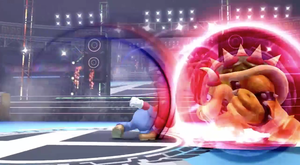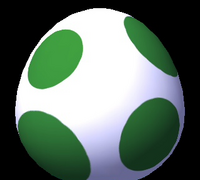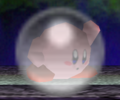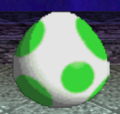Shield
A shield (known as Guard internally) is a bubble of energy that encircles the user. A shield protects the user from a majority of attacks; more specifically, any that are not grabs or determined to be unblockable (including Final Smashes, but not limited to them). The shield is raised by pressing a certain button, which is by default:
- the Z button on the N64 controller and Wii Remote with the Nunchuk
- the L or R button on the GameCube controller, Classic Controller, Wii U Pro Controller, and Wii U GamePad
- the B button on the standalone Wii Remote
- the R button on the Nintendo 3DS, or, on New 3DS models only, the ZL button
- the ZL or ZR button on the Switch Pro Controller and dual Joy-Cons
- the SR button on a standalone Joy-Con
General properties[edit]
Shielding can only be done on the ground; pressing a shield button in midair produces an air dodge instead, or has no effect in the original Super Smash Bros. Shields cannot be held indefinitely; they shrink as time passes and break if held for too long, popping the user up and knocking them down on the ground before stunning them. Blocking attacks accelerates shield depletion relative to the amount of shield damage the attack has. Shields automatically replenish when not in use.
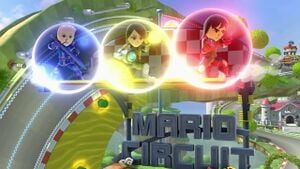
Beginning in Super Smash Bros. Melee, shields match the players' colors; they are red, blue, yellow, and green respectively for players 1 to 4, while CPUs always have a gray shield. In team battles, human players' shield colors instead match their team colors, except if team attack is turned on in Super Smash Bros. Brawl and Super Smash Bros. 4 (Brawl also incorrectly gives green team members a yellow shield). In Smash 64, the shield colors are always red, green, blue, and gray for players 1 to 4, including CPUs and even in team battles; incidentally, these were the colors used for the players in the game's prototype, Dragon King. In Super Smash Bros. for Wii U, with the introduction of 8-Player Smash, players 5 to 8 have orange, cyan, purple, and slate shields, respectively. Super Smash Bros. Ultimate changes players 7 and 8's shield colors to pink and purple, respectively.
In all games to date, shields come out on the very first frame a shield input is recognized by the game. This makes them extremely fast and reliable for defense, as very few attacks come out as equally fast, and many attacks can be easily punished after being shielded. Due to this characteristic, simply approaching an opponent in a rushed way with a move like a dash attack — a common mistake among new players to the series — is usually an unviable tactic; the player is instead encouraged to win the neutral game by getting in close more strategically, being aware of the different options their opponent has, then attack when they are unable to put up their shields, often by forcing them to commit mistakes or bypassing the shield with a move such as a grab. However, shields in all games are still subject to display lag, meaning they will not be activated at the exact same moment the player presses the shield button; this often causes the impression that an attack was not shielded even though the button was pressed.
As aesthetic indicators, when a shield blocks an attack, it briefly glows and displays a circular graphic in the spot the attack was blocked, alongside a sound effect for blocking. In Brawl and Smash 4, a bit of the shield can be seen visually shattering as well, with pieces flying away, whereas in Ultimate, the shield acquires a checkered texture resembling static.
Options from the shield[edit]
When holding their shield, characters' options are generally much more restricted to compensate for their ability to negate most attacks. If the control stick is tilted slightly, the shield can be shifted to help block attacks from specific directions. If it is tilted faster, the shield is instead canceled into a roll with a horizontal tilt, a jump with an upward tilt (if tap jump is turned on), and from Melee onward, a spot dodge with a downward tilt. In all games except Ultimate, characters can also drop through soft platforms while shielding. These options allow characters to leave the shield quickly, reposition themselves while obtaining some intangibility, or quickly retaliate against an attack, such as an opponent attempting to grab them out of the shield. In Ultimate, if the player holds the special move button, more than one shield button, or (oddly enough) a side taunt input while shielding, these options are disabled, allowing players to shift their shield without accidentally becoming vulnerable.
In all games, grabbing and jumping are other possible options out of shield. Since a grab input in the Smash series is coded as a simultaneous shield and attack input, grabbing can simply be done by pressing the attack button while shielding, and is generally the most basic way of punishing opponents out of shield, known as shield grabbing. Jumping out of shield, on the other hand, grants several more options, allowing characters to immediately use their aerial attacks (including SHFFLing in Melee), wavedash, or jump cancel into their up smash or up special. All these options make shielding the centerpiece to a player's defensive game. Characters can also simply drop their shield and use any attack afterwards, though this causes a short inactionable period, usually known as shield drop lag, while all other listed actions can be done instantly out of the shield. In Ultimate, up smashes and up specials can be performed out of shield without the need of jump canceling, allowing players with tap jump turned off to use them more easily.
While in hitlag from shielding an attack, characters can perform a weaker variant of smash directional influence known as shield SDI, allowing them to adjust their distance from the opponent in order to mitigate shield pressure or facilitate a subsequent punish. Characters can also shield out of a run (but not their initial dash), with a short slide forward due to the remaining momentum, which is useful for faking approaches. In Smash 64 and Brawl, a technique known as dashing shield allows characters to conserve more forward momentum when shielding.
Greninja's Shadow Sneak can be used while shielding, but the shield is turned off when doing so.
Technical details[edit]
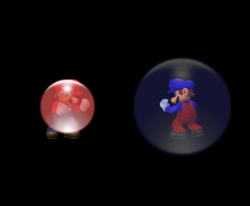
- Though shields block most attacks without fail and come out instantly, their shrinking causes them to not always cover the character's entire damageable hurtbox. As a result, the user can still be vulnerable to shield stabbing.
- For hitbox detection purposes, shields are considered both grounded and aerial, so they can be struck even by hitboxes that can only hit aerial opponents (which would otherwise be impossible to shield). If a move has two sets of ground-only and aerial-only hitboxes occupying the same space, such as Samus' up tilt from Melee onward (which deals 13% to grounded opponents and meteor smashes them, but deals 12% to aerial opponents and launches them diagonally), the hitboxes with the lowest ID hit the shield (in the aforementioned example, the ground-only ones).
- When the shield is hit by an attack, both the attacker and defender experience hitlag as usual, then the defender undergoes an inactionable period known as shieldstun, analogously to hitstun. Shieldstun is generally determined by the shielded attack's damage output, though several other factors can alter it in later games. Hitting a shield also creates shield pushback for the defender and (to a lesser extent) the attacker, separating them to a larger degree the more damage the shielded attack deals; this can even push the shielder off an edge and cause edge slipping, except in Smash 4 and Ultimate.
- If a projectile just barely grazes the outside of a shield (similarly to glancing blows), the projectile is deflected at an angle instead of blocked. Unlike reflection, this does not change its ownership.
- Certain attacks have increased shield damage, meaning that they deal more damage to shields than to other targets. An example is the Fan, which can instantly break a shield with a forward smash. Conversely, some attacks have negative shield damage, and thus deal less damage to shields; this is used by certain strong attacks in Smash 64, such as the Hammer, and by most projectiles in Ultimate from version 3.0.0 onward.
- From Melee onward, blocking an attack right as the shield is raised (with the window depending on the game) triggers a perfect shield, causing the shield to take no damage, reduced pushback (except in Melee), and allowing the character to bypass shield drop lag with any action. In Melee, a portion of this window can also reflect projectiles at half their previous damage. In Ultimate, perfect shielding is instead done by dropping the shield, with a window of 5 frames.
- In Melee only, the L or R button's depression amount can alter the density of the shield, which is known as light shielding. A light shield covers a wider area and shrinks more slowly than a dense shield, but causes more shieldstun and pushback to the user if hit. Holding the Z button to shield (after the character grabs, or if held after another action's ending lag) produces a shield close to the lightest possible amount. Variable shield density was removed in later games, presumably due to other controllers lacking analog buttons, and is the only mechanic in the entire Smash series to utilize analog triggers.
Shield statistics[edit]
In all games from Melee onward, the amount of health a shield loses when hit by an attack is multiplied by a constant. This constant reduces incoming damage in Melee and Brawl, and conversely increases it in Smash 4 and Ultimate, effectively giving the shield more or less HP than its specified amount. Additional shield damage is also affected by this constant, but not shieldstun or shield pushback.
General[edit]
- For maximum HP, the first value lists the raw amount, while the value in parenthesis lists the approximate effective amount with the damage multiplier accounted for.
- For shield depletion and regeneration, the first value lists the HP lost/regained per frame, while the value in parenthesis lists it per second (for example, 0.1 HP per frame equals 6 HP per second).
- For the shieldstun formula, the damage used is the base amount the attack would deal if not shielded, and the result is rounded down in all games except the Japanese version of Smash 64, where it is rounded up.
- Melee statistics only apply to a fully dense shield; analog shield data is listed in more detail in a separate section below.
| Game | Maximum HP | Damage multiplier | Depletion | Regeneration | HP after shield break | Shield time before drop | Shield drop lag | Shieldstun | Size multiplier |
|---|---|---|---|---|---|---|---|---|---|
| 55 (55) | 1× | 0.0625 (3.75/s) | 0.1 (6/s) | 30 | 3 frames | 11 frames | Japanese: damage * 1.75 + 3International: damage * 1.62 + 4 |
? | |
| 60 (85.71) | 0.7× | 0.28 (16.8/s) | 0.07 (4.2/s) | 30 | 8 frames | 15 frames | (damage * 0.45 + 2) * 200 / 201 |
(HP * 0.5 / 60) * 0.85 + 0.15
| |
| 50 (71.43) | 0.7× | 0.28 (16.8/s) | 0.07 (4.2/s) | 30 | 7 frames | 7 frames | damage * 0.345 |
(HP / 50) * 0.85 + 0.15
| |
| 50 (42.02) | 1.19× | 0.13 (7.8/s) | 0.08 (4.8/s) | 25 | 13 frames (prior to 1.1.4) 11 frames (1.1.4 onward) |
7 frames | INT(d * 1.3 + 2) * 0.3 (prior to 1.1.1)damage * 0.58 * mult + 2 (1.1.1 onward) |
(HP / 50) * 0.85 * 1.05 + 0.15
| |
| 50 (42.02) | 1.19× | 0.15 (9/s) | 0.08 (4.8/s) | 37.5 | 3 frames | 11 frames | damage * 0.8 * mult + 2 |
(HP / 50) * 0.85 + 0.15
|
Shield pushback[edit]
The formulas are used to calculate the initial amount of pushback, which is then decayed every frame by the character's traction value. From Brawl onward, attacker traction is multiplied by 1.1× until the pushback ends.
Worth noting is that while the defender's shield pushback has a cap in all games, the attacker's does not. As a result, if an attack that deals extremely high damage is shielded, the attacker can be pushed back with enough strength to be forced off the stage and get KO'd; the Kamikaze glitch is an example of such a scenario. In Ultimate, presumably to protect against this, the damage increase applied by the use of Spirits is not factored in to attacker pushback. In Melee, attacker shield pushback can also cause the ceiling glitch.
Analog shield data (Melee only)[edit]
Several shield properties in Melee are altered if the L or R buttons are not fully pressed. Put in simple terms, lighter shields are larger and take longer to deplete, but take more damage, and increase the defender's shieldstun and pushback, while reducing the attacker's pushback. As a result, they are safer to use preemptively and can prevent shield stabbing much more reliably, but are significantly less effective for subsequent retaliation. This mechanic was dropped for Brawl due to Nintendo dropping support for analog buttons after the GameCube controller and has yet to return to the series.
In all formulas, s is an analog factor equal to n / 140, where n ranges between 43 and 140 depending on how much the L or R buttons are pressed. As a result, s can be as low as 0.30714 with the lightest possible shield, and caps at 1 with a full shield. Shielding with the Z button corresponds to s = 0.35, or n = 49/140.
| Attribute | Formula | Analog variable (a) | Result with lightest possible shield |
|---|---|---|---|
| Damage multiplier | a + 0.7 |
0.2 * (1 - (s - 0.3) / 0.7) |
0.89796× |
| Size multiplier | (HP * a / 60) * 0.85 + 0.15 |
1 - (0.5 * (s - 0.3) / 0.7) |
(HP * 0.9949 / 60) * 0.85 + 0.15
|
| Depletion per frame | (a + 0.1) * 0.14 |
1.9 * (s - 0.3) / 0.7 |
0.0167132 (1.002792 per second) |
| Shieldstun | (damage * (a + 0.3) * 1.5 + 2) * 200 / 201 |
0.65 * (1 - (s - 0.3) / 0.7) |
(damage * 1.415055 + 2) * 200 / 201
|
| Defender shield pushback | (damage * (a + 0.09) + 0.4) * shield |
0.195 * (1 - (s - 0.3) / 0.7) |
(damage * 0.283011 + 0.4) * shield
|
| Attacker shield pushback | damage * a + 0.02 |
(s - 0.3) * 0.1 |
damage * 0.000714 + 0.02
|
Summary[edit]
- Before breaking, a shield with full HP can be held for up to 14.67 seconds in Smash 64, 3.58 seconds in Melee (if fully dense), 2.98 seconds in Brawl, 6.42 seconds in Smash 4, and 5.56 seconds in Ultimate. In Melee, the lightest possible shield with full HP can be held for nearly a full minute before it breaks.
- A shield close to breaking takes 9.15 seconds to fully regenerate in Smash 64, 14.22 seconds in Melee, 11.84 seconds in Brawl, and 10.39 seconds in Smash 4 and Ultimate.
- After a character's stun from a shield break ends, the shield is reset to 54.55% of its HP in Smash 64, 50% in Melee and Smash 4, 60% in Brawl, and 75% in Ultimate.
- Smash 64 shields are notoriously durable on their own, having the slowest depletion and fastest regeneration of all shields in the series. However, the game's extremely high shieldstun and quick grabs with exceptionally strong throws leaves them at a glaring disadvantage for direct retaliation, even allowing for shield break combos from certain characters. Additionally, and only in this game, throws from a shield grab after shieldstun only deal half their usual damage, further reducing viable out of shield options.
- Melee shields are the most durable in the series, with an effective 85.71 HP when fully dense (66.82 HP at their lightest). Alongside their significantly lower shieldstun than Smash 64 shields, this gives characters more pronounced out of shield games, and makes shield breaks a rarity, with moves such as Shield Breaker necessitating a very high amount of shield damage to pull this off. However, due to their small size and fast depletion rate when fully dense, they are riskier to use and encourage different shield densities depending on the situation.
- Brawl shields are usually considered the most effective in the series, due to their low shieldstun and shield drop lag allowing them to punish attacks very easily (further compounded by attacks being overall less advantageous than in previous games), as well as still being highly durable with a consistent and effective 71.43 HP, having less HP than a fully dense shield, but higher than the lightest shields. However, they also have the fastest depletion rate in the series, and can still be subjected to edge slipping, discouraging their reckless overuse.
- Smash 4 shields have more favorable depletion and regeneration rates than Melee and Brawl's, alongside having less shield pushback and no longer being vulnerable to edge slipping. However, with an effective 42.02 HP (less than half of fully dense Melee shields), they are notoriously more fragile, making shield breaks from moves without additional shield damage fairly more common, to the point of even a few consecutive smash attacks being capable of breaking shields. As a result, their risk of use lies more in directly attempting to shield powerful attacks rather than simply holding them for too long.
- Ultimate shields remain similar to Smash 4's, except they have a slightly faster depletion rate, longer shield drop lag, and increased startup on shield grabs after shieldstun, as well as generally taking more shieldstun from non-aerial physical attacks. This overall brings them to a more balanced state, being neither too disadvantaged against attacks like in Smash 64, nor too safe of a punish option like in Brawl.
Shield breaking[edit]
Shields are larger the more health they have remaining, in addition to each character having their own shield size ratio. As the shield is raised and blocks attacks, it keeps diminishing until it breaks. This phenomenon is known as a shield break, and results in the character being launched a distance upward (a shield jump), getting knocked down as they land, then being stunned for some seconds after standing up. The stun duration is dependant on the victim's damage percent – the less damage they have, the longer it will last, with mashing accelerating this process to an extent. Any attack that causes a stunned fighter to flinch ends the stunned state.
The purpose of shields breaking and diminishing is, along with grabbing, to prevent players from protecting themselves indefinitely. Instead, as the shield gets smaller, a larger portion of the character's hurtbox is left vulnerable to attacks. Shield breaking is commonly done either by taking advantage of shieldstun to chain several attacks with little room for the opponent to escape, or by landing attacks that deal high enough shield damage, such as Marth's Shield Breaker or throwing Mr. Saturn. Shield breaking is especially dangerous at the edge of a stage, as due to shield pushback from the move that broke the shield, the character can get pushed off and continue falling until they reach the bottom blast line, leading to an inevitable KO.
Jigglypuff is affected more severely by shield breaking than any other character, as it is launched upward several hundred times farther than normal, which is more than enough to instantly KO Jigglypuff in any situation unless there is an overhead obstruction (in which case, it will helplessly keep trying to float up until several seconds have passed, the obstacle is removed, or Jigglypuff is smacked out of it). This has lead to some strategies involving shield breaking Jigglypuff to perform skips in speedruns and some niche stalling strategies on certain stages by remaining in the air below a ceiling, essentially being unreachable for several seconds.
In Melee, having one's shield broken by an opponent rewards the player with Shattered Shield bonus, worth −1000 points, while breaking their own shield rewards them the Shield Stupidity bonus, worth −2000 points. Breaking another opponent's shield rewards the character the Shield Buster bonus, worth 2500 points. All three of the bonuses can stack, and performing the required tasks multiple times proportionally increases their value.
Players who use Rosalina & Luma are still able to control Luma's attacks even if Rosalina is stunned from a shield break.
Characters with unique shields[edit]
Yoshi[edit]
In all games, Yoshi is notorious for having a unique shield from every other character. Instead of using a bubble, he curls up inside a Yoshi Egg that does not shrink. Instead, as the shield weakens, the egg gradually acquires a darker tint until becoming completely black, similarly to the effect used by players' damage meters as their percentage increases. This is generally an upgrade over other characters' shields, as it effectively renders Yoshi immune to shield stabbing (except in Brawl, where a small part of his feet's hurtboxes still poke out of the shield), and eliminates the necessity of shifting the shield; however, it also has the disadvantage of his shield being easier to break, leading to a potentially more severe punish than if he merely got shield stabbed.
Depending on the game, Yoshi's shield also has several different properties from other characters' shields, both positive and negative.
In Smash 64[edit]
 The initial 3-frame animation where Yoshi curls up into the shield grants him invincibility, effectively giving him a short window to block attacks without any hitlag, shield damage, shieldstun, or shield pushback, and preventing him from being grabbed out of the shield right away. This technique is known as parrying, and allows Yoshi to punish attacks out of shield much more effectively, though it is also very precise.
The initial 3-frame animation where Yoshi curls up into the shield grants him invincibility, effectively giving him a short window to block attacks without any hitlag, shield damage, shieldstun, or shield pushback, and preventing him from being grabbed out of the shield right away. This technique is known as parrying, and allows Yoshi to punish attacks out of shield much more effectively, though it is also very precise. His shield drop lag is higher, with 15 frames instead of 11, hindering his ability to act out of shield if he fails to parry an attack.
His shield drop lag is higher, with 15 frames instead of 11, hindering his ability to act out of shield if he fails to parry an attack.
In Melee[edit]
 Yoshi is invincible during the first 6 shield frames, and can drop the shield after 7 frames, slightly faster than other characters' 8 frames. However, his shield still comes out immediately with an analog L/R press, or in 3 frames with a digital press, and takes priority over his hurtboxes, reducing the utility of parrying compared to Smash 64.
Yoshi is invincible during the first 6 shield frames, and can drop the shield after 7 frames, slightly faster than other characters' 8 frames. However, his shield still comes out immediately with an analog L/R press, or in 3 frames with a digital press, and takes priority over his hurtboxes, reducing the utility of parrying compared to Smash 64. Yoshi's shield takes no shieldstun, allowing him to act out immediately after hitlag.
Yoshi's shield takes no shieldstun, allowing him to act out immediately after hitlag. He cannot jump out of shield, except during the first 6 shield frames with a digital press, which alongside his slow grab severely limits his ability to punish attacks opportunely.
He cannot jump out of shield, except during the first 6 shield frames with a digital press, which alongside his slow grab severely limits his ability to punish attacks opportunely. He uses a different shield pushback formula, corresponding to
He uses a different shield pushback formula, corresponding to damage * a + 0.4, with a being determined by0.3 * (1 - (s - 0.3) / 0.7). As a result, he slides much farther away than other characters with a light shield, but only a small distance independent of damage taken with a full shield, giving him a different dynamic against shield pressure. Yoshi's powershield behaves unusually. Due to his shield not being immediately active with a digital L/R press, his initial window for powershielding physical attacks is shorter; however, he is capable of "storing" the powershield if he acts out of its 4-frame window, allowing him to powershield a physical attack (but not projectiles) during any portion of a subsequent shield, provided he doesn't reset the count with another digital L/R press.
Yoshi's powershield behaves unusually. Due to his shield not being immediately active with a digital L/R press, his initial window for powershielding physical attacks is shorter; however, he is capable of "storing" the powershield if he acts out of its 4-frame window, allowing him to powershield a physical attack (but not projectiles) during any portion of a subsequent shield, provided he doesn't reset the count with another digital L/R press.
In Brawl[edit]
 Yoshi takes one frame less to drop his shield after putting it up, with 6 frames instead of 7.
Yoshi takes one frame less to drop his shield after putting it up, with 6 frames instead of 7. His shield drop lag is considerably higher, remaining at 15 frames instead of being reduced to 7 frames like every other veteran's.
His shield drop lag is considerably higher, remaining at 15 frames instead of being reduced to 7 frames like every other veteran's. He cannot jump out of shield altogether (unlike in Melee, where he still had a short window to do so), nor glide toss. Combined with his higher shield drop lag, and no longer being immune to shieldstun, Yoshi's shield in Brawl and his resulting defensive game is considerably worse than the rest of the cast's.
He cannot jump out of shield altogether (unlike in Melee, where he still had a short window to do so), nor glide toss. Combined with his higher shield drop lag, and no longer being immune to shieldstun, Yoshi's shield in Brawl and his resulting defensive game is considerably worse than the rest of the cast's.
In Smash 4[edit]
 Yoshi takes less time to drop his shield after putting it up, with 8 frames instead of 11.
Yoshi takes less time to drop his shield after putting it up, with 8 frames instead of 11. Unlike in previous games, Yoshi is unable to shield platform drop, being the only character with this distinction.
Unlike in previous games, Yoshi is unable to shield platform drop, being the only character with this distinction.
In Ultimate, due to the changes to shield time and the removal of shield platform dropping, Yoshi's shield no longer has practical differences from the rest other than its fixed size, making it generally more advantageous.
Jigglypuff[edit]
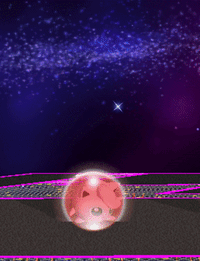
While Jigglypuff uses the same bubble shield as other characters, its shield jump in all games is uniquely more punishing. The force Jigglypuff is sent upwards with if its shield breaks is equivalent to taking 300 units of vertical knockback, which is more than enough to cause it to self-destruct on every stage if there is no overhead obstacle. However, this can also be useful for certain situations in single-player modes, such as the Brinstar Escape Shaft in Melee's Adventure Mode and The Glacial Peak in the Subspace Emissary.
Unique actions out of shield[edit]
In Ultimate, while Inkling and Steve's shields are identical to other characters', they have access to unique actions by pressing the special move button while shielding. Inkling changes into squid form and refills her Ink Tank from the ground, then changes back to normal after completely refilling the Ink Tank or if the button is released. On the other hand, Steve summons his Crafting Table to his current location, at the cost of some materials. This aids both characters with their respective fighter abilities, allowing Inkling to regain ink for attacks that utilize it, and Steve to use his Crafting mechanic more conveniently. However, these actions cause them to leave the shield and thus become vulnerable to attacks, although Inkling still has a reduced hurtbox size while recharging ink, while Steve can act 7 frames after summoning a crafting table, effectively giving him a faster shield drop than other characters at the cost of materials and the ability to parry.
Since these actions are performed with the special move button, Inkling and Steve players can only use the "shield shift lock" feature by holding multiple shield buttons or a side taunt input. Oddly enough, this also applies to Snake, despite him having no unique shield actions.
Origin[edit]
The concept of blocking attacks is a standard amongst the fighting game genre. In traditional fighting games, blocking involves characters bracing against attacks (such as by holding up their arms), which typically prevents the character from flinching or being affected by any of the attack's effects or gimmicks. Blocked attacks may still deal minimal damage referred to as "chip damage" depending on the game and/or type of attack blocked (normally applies to damaging special moves), and blocking too many attacks can break the character's guard and leave them vulnerable. Many fighting games require players to choose between blocking high or low attacks and do not allow players to block grabs or attacks from behind.
In Kirby Super Star, Kirby is capable of blocking attacks in a way reminiscent of most traditional fighting games—protecting him from flinching or losing his ability while still dealing minor damage if the attack is strong enough—though he automatically guards from all directions. In addition, if Kirby has the Mirror ability, guarding produces a multi-colored bubble around his body that blocks all non-grab attacks without chip damage and is even capable of reflecting certain projectiles. It is this bubble that appears to be the inspiration for the shield bubble in the Super Smash Bros. series. The Smash Bros. bubble would later make an appearance in Kirby's Smash Bros ability in Kirby: Planet Robobot, functioning identically to that of the Mirror ability.
Yoshi's shield design, on the other hand, is possibly based on an occurrence in Super Mario World 2: Yoshi's Island. When Baby Mario grabs a Super Star and starts running around, Yoshi follows by hiding in an egg and becoming part of his egg trail. The duo is invincible during this time. The shield may also be based on Yoshi becoming invincible once swallowing a Turbo Tulip in Yoshi's Story, although that is generally attributed to the Egg Roll instead.
Inkling's method of refilling ink is derived from their home series, where the player's ink can be refilled by turning into squid form and diving into ink of the same color. In these games, turning into squid form is mapped to the![]() button; the ZL and ZR buttons shield by default in Super Smash Bros. Ultimate.
button; the ZL and ZR buttons shield by default in Super Smash Bros. Ultimate.
Gallery[edit]
A CPU Kirby shielding in Smash 64.
Captain Falcon shown angling his shield upward in Smash 64 to block an incoming attack from Samus.
Yoshi's shield in Smash 64.
Mario's shielding animation in Melee.
Mario's stunned animation in Melee.
Zero Suit Samus shields to defend herself against Snake's attack.
Trivia[edit]
- If the Shadow Assist Trophy freezes a character while shielding, the shield will remain up until being unfrozen. Shield decay does not trigger, though it shrinks after being hit as normal. If the frozen character's shield is broken, they will immediately be unfrozen and receive the shield break effect as normal, temporarily disabling the background caused by Shadow before it quickly returns.
